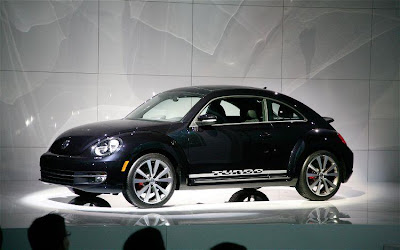It's never easy to reinterpret a design icon on the order of the Volkswagen Beetle, one of the most recognizable vehicles ever. But with the New Beetle getting old, the time has for the 2012 Volkswagen Beetle. One of the most anticipated new VWs in recent memory, the 2012 Beetle is getting the VIP treatment with a simultaneous world premiere in Shanghai, Berlin, and at this week's 2011 New York show.
So while the new Beetle is in fact new, it is still very much a Beetle. While the trademark round fenders are present and accounted for, the bubble roof that became a calling card of the New Beetle has been flattened out into a roofline more reminiscent of the original Beetle. The result is a new C-pillar that's more faithful to the original, and a more vertical rear hatch. Much like the distantly related Porsche Panamera, not to mention the original Beetle, this means more usable headroom for rear seat passengers, something the New Beetle was lacking.
There are other substantial aesthetic changes. The new nose is longer and flatter, again like the original, and drops down onto a lower fascia that incorporates just enough of the new Volkswagen corporate grille to be recognizable. The headlights are, for the first time, bi-xenon HIDs with crescents of LED running lights framing their outboard edges. New running boards hint at the original Beetle, while a wider rear hatch rectifies another New Beetle shortcoming. An integrated spoiler is standard with the top-shelf engine.
If the 2012 VW Beetle looks wider and lower, that's because it is. To make the car look more masculine and muscular, Volkswagen widened the new Beetle by 3.3 inches and lowered the overall height by half an inch. In another bonus for the rear seat passengers, the car has also been stretched 6 inches longer overall and the wheelbase is longer, though Volkswagen hasn't said by how much. Optional 19-inch wheels, dual exhaust, and a performance and handling package will further its sporty aspirations.
Providing the actual sportiness will be Volkswagen's well-worn, turbocharged 2.0-liter four-cylinder engine with its 200 horsepower and 207 pound-feet of torque fed to either a six-speed manual or a DSG six-speed dual-clutch automatic and Volkswagen's XDS electronic differential. The combination is good for 30 mpg highway, Volkswagen says. For the fuel economy-inclined, the 2.0-liter turbodiesel four-cylinder found in multiple VW offerings with 140 horsepower and 236 pound-feet of torque returns 29 mpg city and 40 mpg highway. The 2.5-liter inline-five hangs on as the entry-level engine but now produces 170 horsepower and 177 pound-feet of torque. A five-speed manual should return 22 mpg city and 31 mpg highway, while a six-speed auto should give 22 mpg city and 29 mpg highway.




No comments:
Post a Comment